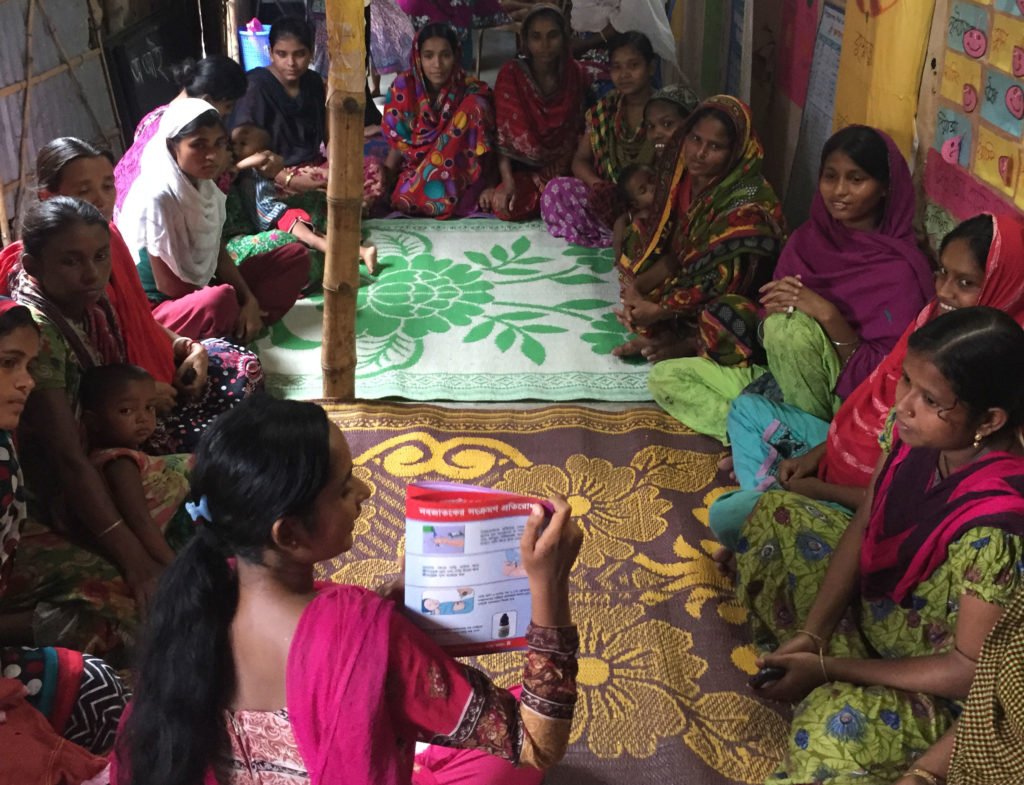
by Brittany Monks
Sitting on the floor of Save the Children’s bright and child-friendly resource center in a densely-populated urban slum in Dhaka, Bangladesh, I was surrounded by pregnant women listening to a lesson on newborn care. As the Save the Children staff person taught the women about cord care, breastfeeding and warning signs, the women were warm and welcoming to our group of visitors, but they were clearly present to learn. Approximately one out of every 30 children in Bangladesh die before their fifth birthday and 59 percent of those deaths occur in the first 28 days of life, making that day’s lesson especially relevant. I would later learn that multiple women in the room had lost one or more of their children, most likely from preventable or treatable causes like pneumonia or diarrhea.
After the lesson concluded, the women introduced themselves and I learned that many of them were similar in age to myself, despite their petite nature. Furthermore, I was surprised to hear that a group of them who looked early on in their pregnancies were in fact due in just three months. We didn’t take height measurements that day but I am certain that many of the women would have been below the median for their age, making them by definition, stunted.
The truth about stunting – defined by the World Health Organization as low height-for-age based on international child growth standards – is that it starts in utero and can impact multiple generations within one family. This means that a mother who is stunted can do little to prevent her child from being born stunted and suffering from lifelong undernutrition.
I saw this first hand when I visited Save the Children’s programs in Bangladesh last year.
What does stunting mean for women and children?
It is a fact that childhood stunting is virtually irreversible, despite interventions later in life. Therefore, we must act early in women’s lives to break the intergenerational cycle of poverty and undernutrition.
With a multi-sectoral approach targeting multiple causes of maternal undernutrition – lack of dietary diversity, lack of access to health services and poor sanitation and hygiene, just to name a few – research shows we could save millions of lives. And by focusing on the poorest and most marginalized populations, we can make progress towards the World Health Assembly’s goals.
In 2012, the United States endorsed a set of global nutrition targets set by the World Health Assembly. These ambitious targets focus on achieving progress in six key areas of maternal, newborn and child nutrition by 2030: stunting, anemia, low birth weight, overweight, breastfeeding and wasting. The following year, in 2013, the United States continued this momentum by committing to reduce the number of stunted children by two million by 2025 at the Nutrition for Growth Summit in London.
As one of the world’s leading non-profit organizations focused on children’s issues, Save the Children applauded the United States for making these unprecedented commitments to women and children around the globe.
Unfortunately, only a few years later, the majority of countries are off track in meeting these goals –undernutrition continues to be the underlying cause of 45 percent of global child death, amounting to three million preventable child deaths each year.
What can the United States do to help?
As we look ahead to 2030, the United States has a critical opportunity to step forward as a global leader for maternal, newborn and child nutrition and to help provide women in Bangladesh, and around the globe, with the resources they need to protect their children from preventable deaths.
This would take significant policy and financial commitments, including specific targets for anemia, breastfeeding and wasting, and an updated target for stunting – four areas that the United States already invests in, but could do much more. By committing to specific targets that contribute to the World Health Assembly’s goals, the U.S. would set an example for other countries to do the same. Save the Children and Save the Children Action Network look forward to the announcement of the next Nutrition for Growth pledging moment in 2017, where we hope the next administration will make these concrete commitments.
Working to eliminate malnutrition will bring us one step closer to realizing a world where every mother and child can achieve their fullest potential.